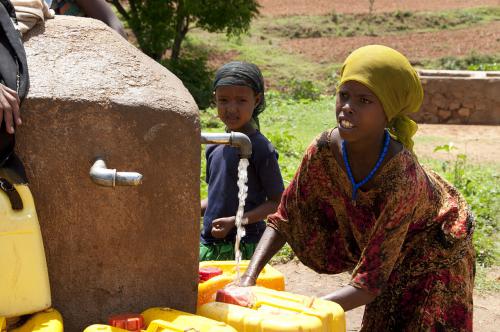Water securityWater storage strategies in Sub-Sahara Africa
Direct abstraction of water from rivers through ponds and pumping devices seems the most attractive water storage option in Ethiopia. However, the funding agencies that may be interested in investing in such a storage system have to consider that better access to credit, and clear abstraction policies should be ensured.

ocal girls from Babile fill yellow water jugs at the area's main water source // Source: wikipedia.org
Direct abstraction of water from rivers through ponds and pumping devices seems the most attractive water storage option in Ethiopia. However, the funding agencies that may be interested in investing in such a storage system have to consider that better access to credit, and clear abstraction policies should be ensured.
World Scientific reports thatthe current study proposes a multi-criteria decision aid framework to funding agencies for the integrated evaluation of water storage systems in Ethiopia and more broadly in Sub-Saharan Africa. Various water storage schemes within the country are assessed while the farmers are placed at the center of the analysis as the principal stakeholders. The approach is based on a multi-criteria outranking method for the avoidance of complete trade-offs between criteria.
Throughout Sub-Saharan Africa (SSA), past storage development has largely occurred in a piecemeal fashion, through local initiatives and with minimal planning. In some cases lack of information and planning has resulted in less than optimal investments. Population growth, in conjunction with climate change, will increase the importance of water storage but without greater understanding of which types of storage are best utilized under specific agro-ecological and social conditions it is likely that many water storage investments will fail to deliver the intended benefits.
To ensure sustainability, national policies are needed that promote much more rigorous and integrated planning of all water storage options. World Scientific notes that to this end, the current study suggests outranking assessment as a tool that facilitates the systematic inclusion of a wider range of criteria in planning processes. In combination with existing approaches it could contribute significantly to better planning of water storage throughout SSA.
The study presents an integrated assessment approach for funding agencies and organizations as a promising option to better evaluate the performance of water storage in Sub-Saharan Africa.
The study was carried out within the project “Rethinking Water Storage for Climate Change Adaptation in Sub-Saharan Africa”. This multidisciplinary project (2008-2011) was funded by the German Federal Ministry for Economic Cooperation and Development.
— Read more in Stefanos Xenarios et al., “Developing a User-Based Decision-Aid Framework for Water Storage Systems in Sub-Saharan Africa: The Case of Blue Nile Basin in Ethiopia,” Water Economics and Policy 1, no. 4 (December 2015) (DOI: 10.1142/S2382624X15500125)
